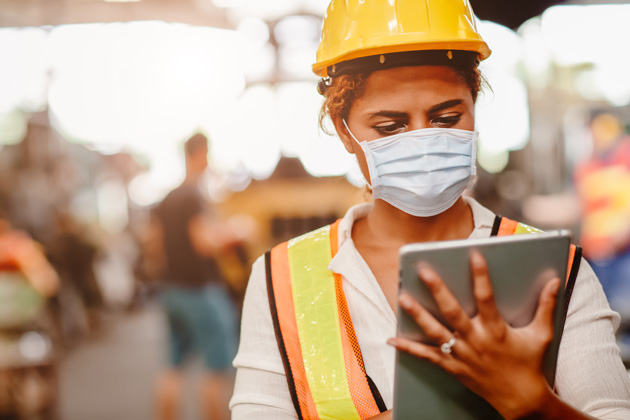
Keeping workers safe has always been a concern for employers, particularly for those in industries like construction that are inherently more dangerous, and COVID-19 adds a whole new dimension to that risk. As the early days of the pandemic demonstrated, shutting down sites, laying off or furloughing workers or working with skeleton crews was only sustainable for the short term. Businesses had to get back to work and find new ways to adapt to remain afloat, keep workers employed and productive, build much-needed infrastructure and address supply chain shortages. Terms like “social distancing,” “contact tracing” and “Emergency Use Authorization (EUA)” are now key terms in company handbooks, safety checklists and training manuals.
To have a truly safe workplace requires changes that are tangible and intangible. It requires systemic changes in a company’s culture to put safety above all else, as well as making rigorous protocols and operating procedures second nature. Encouraging workers to remain at home if they are not feeling well, and instituting strict cleaning regimens, the use of masks, regular temperature checks and wellness questionnaires must become standard practice. In addition, technology has become a valuable tool in combating COVID-19 risk in the workplace.
Companies typically use manual processes, but now recognize the need to take a digital-first mindset to keep workers safe. To continue keeping their businesses running and ensuring that workers remain employed, they have embraced technologies like wearable devices and analytics that are part of internet of things (IoT) solutions. These technologies are helping to support changing workplace cultures and priorities that will remain long after COVID-19 has been controlled.
Building a Tech Arsenal
According to technology analysts at Gartner, there are two types of approaches to using technology to fight COVID-19. One is using proactive technology that instills safer behaviors like wearing masks and social distancing. The other is with reactive technology, which addresses activities after a risk incident has occurred, such as contact tracing and quarantining.
Safe Social Distancing
IoT-based wearable sensors are addressing both proactive and reactive approaches, proactively enabling safe social distancing and reinforcing safe worksite behaviors, as recommended by the Centers for Disease Control (CDC).
These solutions are addressing workers having difficulty maintaining social distancing from each other on a complex worksite where they often need to work together on projects. When workers are focused on their specific tasks, they may not be aware of their proximity to another worker. These considerations can also be distracting, especially when operating dangerous machinery or tools. Today, workers can wear advanced IoT devices to communicate with other devices and send out an audible and visual alarm when they come into close contact with one another.
Additionally, through data-driven insights into close interactions between workers, companies, (like manufacturers, construction firms and others) can make more informed decisions about changing standard operating procedures (SOPs) or protocols. For example, one major manufacturer of agricultural products found it difficult to keep workers six feet apart during maintenance shutdown and turnarounds at its facilities, since it required more than eight times the number of people to be onsite as compared to normal operations. By using wearable sensors that provided audible social distancing reminders when workers were too close and tracking close interactions through the data, it was able to accommodate the increased number of workers while keeping the site safer. Companies in construction, manufacturing and other industries are finding that interactions between employees and their duration have dropped by 50%, simply by using IoT wearable devices.
Swift Contact Tracing
Companies are also using IoT technologies reactively when an outbreak occurs at facilities. Wearable devices enable automated contact tracing and record close contact interactions among specific workers. They allows manufacturers to identify—within minutes, instead of hours or days—all close-contact interactions with the infected individual, and quarantine only those who have been exposed, instead of entire workforces. This is critical to preventing a major outbreak or a complete plant shutdown.
Additionally, since worker privacy is a key concern, some digital contact tracing solutions allow each employee to be anonymized for privacy purposes, so that only authorized managers know the identity of each assigned IoT sensor holder, to carry out proper notifications in the event of exposure.
AI-Driven Analytics
Companies are also using predictive analytics and deep learning technologies to fight COVID-19. Predictive analytics can help identify patterns of behavior to better predict future outcomes. For example, there may be more incidences of close proximity during busy shifts. Predictive analytics can forecast the likelihood of these incidences so that proactive action can be taken, such as adding a new shift to decrease the number of workers needed at a given time, or helping managers determine if workers are following safety protocols.
Changing Policies, Cultures and Procedures
Employers must use all the tools at their disposal to keep worksites safe, starting with a culture that elevates safety. This can include rigorous safety protocols and operating procedures, and the use of smart technologies.
Long after breakthrough vaccines have controlled the pandemic, new safety protocols and tech solutions will remain, as companies everywhere realize the benefits for employees, as well as their impact on corporate risk.
